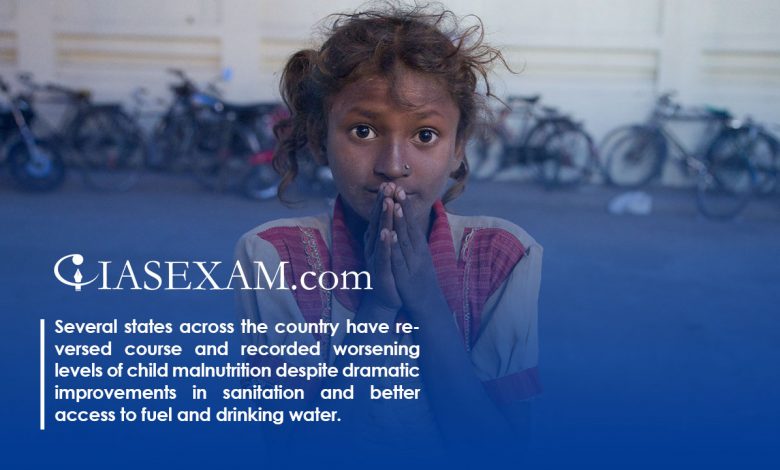Malnutrition in kids worsens in key states 2015-19

Several states across the country have reversed course and recorded worsening levels of child malnutrition despite dramatic improvements in sanitation and better access to fuel and drinking water.
This is one of the startling revelations in the first-phase data of the National Family Health Survey (NFHS) 2019-20 — released by the Union Ministry of Health and Family Welfare on December 12 — and marks a shift since the last NFHS in 2015-16.
The latest data pertains to 17 states — including Maharashtra, Bihar, and West Bengal — and five Union Territories (including J&K) and, crucially, captures the state of health in these states before the Covid pandemic. Phase 2 of the survey, which will cover other states such as Uttar Pradesh, Punjab and Madhya Pradesh, was delayed due to the pandemic and its results are expected to be made available in May 2021.
Data from the first phase shows that several states have either witnessed meagre improvements or sustained reversals on child (under 5 years of age) malnutrition parameters such as child stunting; child wasting; share of children underweight and child mortality rate.
These four are key metrics and their data are used in several global indices such as the Global Hunger Index.
Child wasting reflects acute undernutrition and refers to children having low weight for their height. India has always had a high level of child wasting but instead of reducing it, several states such as Telangana, Kerala, Bihar, and Assam as well as the UT of J&K have witnessed an increase.
Others like Maharashtra and West Bengal have been stagnant on this.
When it comes to the proportion of underweight children, again, several big states, Gujarat, Maharashtra, West Bengal, Telangana, Assam and Kerala, have seen an increase.
But the most surprising reversals have happened in child stunting, which reflects chronic undernutrition, and refers to the percentage of children who have low height for their age.
Stunting, more than any other factor, is likely to have long-lasting adverse effects on the cognitive and physical development of a child.
Opinion | Improving capacities of anganwadis is one of the ways to improve the country’s woeful record in addressing malnutrition
Telangana, Gujarat, Kerala, Maharashtra, and West Bengal — all saw increased levels of child stunting.
According to Purnima Menon, a senior research fellow at the International Food Policy Research Institute, the reversals in child stunting are “hugely troubling”.
“One has not seen stunting increases in most of the world,” she said. “Normally, we do not see stunting levels increasing because all the things that affect child growth tend to improve as stable democracies and economies move ahead.”
Infant Mortality Rate — that is, the number of deaths per 1000 live births for children under the age of 1 — and Under 5 Mortality Rate data, too, is mostly stagnant.
Aashish Gupta, a researcher affiliated with the University of Pennsylvania, said that between NFHS-3 (2005-05) and 4 (2015-16), there was progress on mortality reduction.
“Under 5 mortality was observed to be 74 deaths per 1,000 births in NFHS-3, and 50 deaths per 1,000 births in NFHS-4, a decline of about 33% over 10 years. NFHS-5 and NFHS-4 are about five years apart, but we are seeing very little progress in many states. In Maharashtra, the under-5 mortality rate is basically the same in NFHS-4 and 5, and in Bihar, it reduced by just 3% over five years,” he said.
Menon said that over 60 per cent of child mortality is explained by poor nutrition. In other words, child malnutrition is the central problem.
Source: Indian Express





.png)



